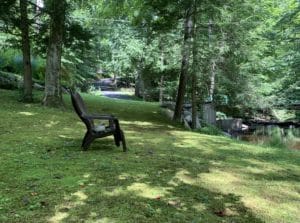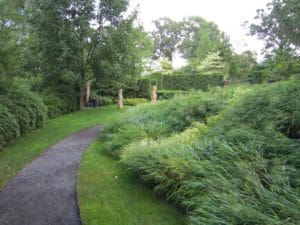Hello Fellow Readers,

Clover’s natural nitrogen-fixer is less likely to leach into water supplies than synthetic fertilizers.
Last week’s chat about Dutch clover (Trifolium repens) as a lawn alternative created quite a buzz. Beyond the buzz of our happy pollinators scurrying from bloom to bloom. It seems the algae bloom on New Jersey’s Lake Hopatcong has brought the devastating dilemma of lawn fertilizers running into water supplies to light. No swimming or contact with the water has been allowed for weeks. Many lake associations insist on no-phosphate fertilizers. But it turns out nitrogen is just as impactful in encouraging the growth of algae, most of which are not harmful or toxic.
A Brief about Algae Bloom: “Often referred to as blue-green algae, cyanobacteria are not true algae but are capable of excessive growth through photosynthesis,” writes the NJ Department of Environmental Protection. “Cyanobacteria blooms are usually bright green, but can also appear as spilled paint, pea soup, or as having a thick coating or mat on the surface.” It’s not pretty and very toxic. The nutrient enrichment of our waterways, primarily phosphorus and nitrogen explains Purdue University, is a chief factor in sustaining the growth of algae and Cyanobacteria. Temperature, sunlight, water chemistry, water flow, and storage levels impact algal blooms as well.
Clover doesn’t need fertilization as it’s a natural nitrogen-fixer that’s less likely to leach into water supplies than synthetic fertilizers writes Rutgers University.
There are other lawn alternatives to consider. Though it’s true, while clover lawns are ideal for play and pets, the following are for light foot traffic only.
For sunny spots, there’s creeping thyme (Thymus praecox). My favs are ‘Elfin’ which creates the tightest matt but rarely flowers – a good thing when walking barefoot. There’s the ambitious ‘Pink Chintz’ if you prefer lovely long-lasting salmon-pink blooms.
Mazus (Mazus reptans) is ideal for sunny or shady sites, though it needs to remain moist. It only grows two inches tall with dense foliage. Their adorable purplish-blue blooms in late spring are a bonus.
Of course, I adore the carefree mossy “lawn” nature created by our brook that’s green all year long.
Just recently I designed a garden surrounding a barn converted into a home. The owners wish for minimal maintenance but have an expansive front foundation area. Along with a simple planting of assorted shrubs, I suggested a swath of sedge to replace the lawn now there. Appalachian sedge (Carex appalachica) is native to these parts with a tidy flowing habit and fine grass-like blades which will be happy in their shady, dry spot. There’s also Creek sedge (C. amphibola), considered a native alternative to Liriope, with shiny narrow foliage ideal for shady areas in need of erosion control.
I marvel over elegant swaths of Hakonechloa macra adorning a hillside. Commonly called Japanese Forest Grass or Hanoke Grass, it looks lovely dry in winter with golden wisps that dance in the breeze. There are many varieties suitable for shade to full sun.
There’s also soft-looking but robust Pennsylvania sedge (C. pensylvanica) that’s ideal as a shade lawn alternative. It’s foliage forms dense mats that grow only six to eight inches high if not mowed. For you mow-happy folks, it looks best when cut to three or four inches tall (no shorter my dear Curt) but only two to three times per year. An early cut close to the ground for all sedges, before the new growth emerges in spring, “is allowed” if needed to neaten up winter burn. Other than that, just let her grow! Garden Dilemmas? AskMaryStone@gmail.com
Links to Lawn Alternatives Listed Above:
I invite you to click through to last week’s column – Clover Lawn Alternative
Mazus (Mazus reptans)
Appalachian sedge (Carex appalachica)
Creek sedge (C. amphibola)
Pennsylvania sedge (C. pensylvanica)
Japanese Forest Grass or Hanoke Grass (Hakonechloa macra)





